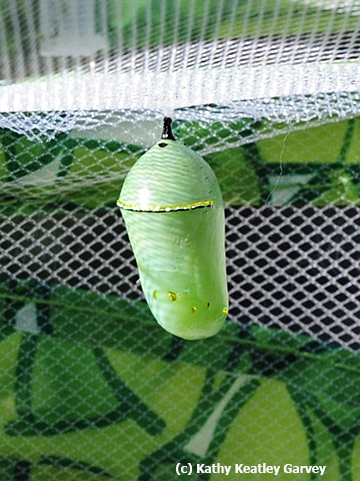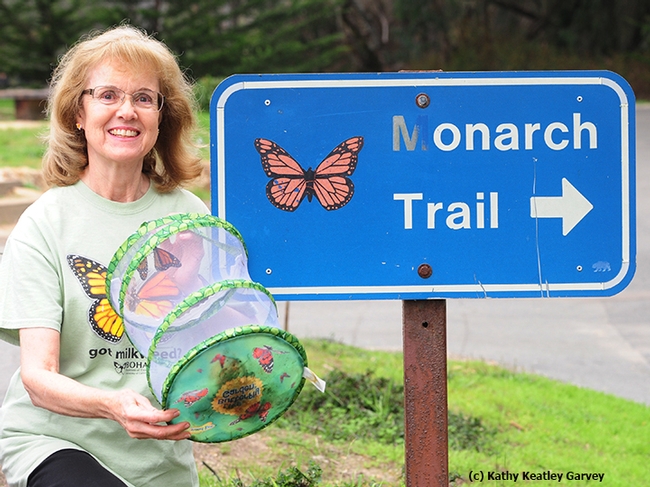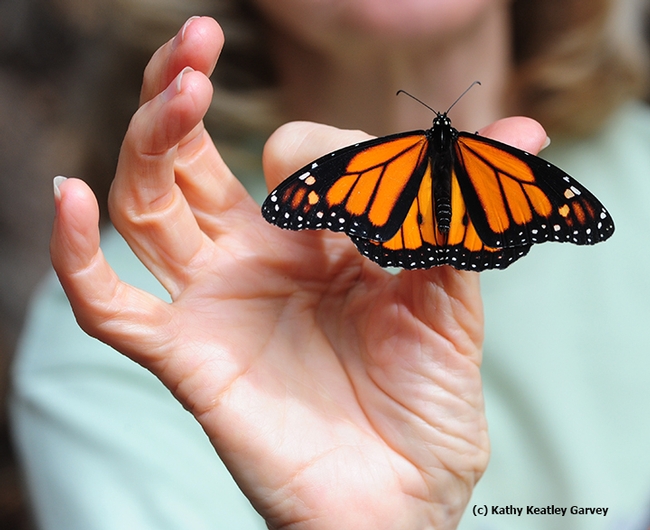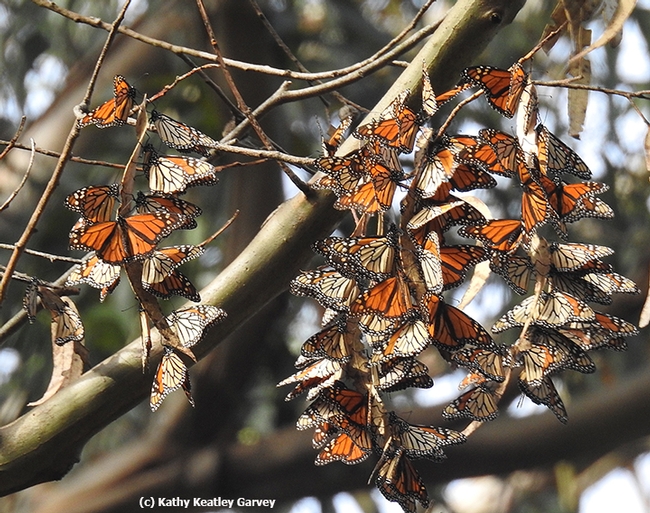
Then it happened. The three monarchs caterpillars that we'd been rearing in our indoor butterfly habitat, pupated, forming those familiar, awe-inspiring jade-green chrysalids. Soon three monarchs--two males and a female--eclosed.
Should they go? Or should they stay?
The first monarch, a male, eclosed on Tuesday, Nov. 8, Election Day. What to do? Wait for the other two to eclose and drive them all to Santa Cruz—since we're going there any way on Monday, Nov. 14-- or release him now? Decisions, decisions, decisions.
An inner voice argued with me.
Me: “Release him. Let him be a butterfly.”
Inner Voice: “If we transport him there, he'll have a better chance of survival. It's November and pretty late in the migratory season for him to make that 113-mile journey. He can join the cluster of 800 to 1000 already there, overwintering high and happily in the eucalyptus trees, and then next February, he'll head inland.”
Me: “No. Release him. He's antsy. He wants out. Besides, how do you know if wants to go to Santa Cruz? Maybe that's not on his itinerary!”

So off went Butterfly No. 1, soaring 80 feet high into the air. He never looked back.
Then a female eclosed on Thursday, Nov. 10 and a male on Friday, Nov. 11, Veterans' Day. The weather report indicated rain within the next few days. Release them or drive them to Santa Cruz?
Me: “Well, since we're going there any way on Nov. 14, and the monarch population is declining, why not take these two to Santa Cruz?”
Inner Voice: “Yes! Why not?”
So off we went, Don, Marilyn, Jim, yours truly and the two monarchs, Danaus plexippus, well fed and roosting comfortably in their mesh butterfly habitat.
We left Fairfield mid-morning on Nov. 14, and after a 90-minute trip, arrived at Natural Bridges around noon. It was a picture-perfect autumn day, a day to treasure, with temperatures at 60 degrees and rising. And, there we were, standing in the monarch sanctuary, in awe of a thousand tiny butterflies silently clustering in the towering eucalyptus trees. From 80 feet below, the drab-graylike clusters looked ever so much like dead leaves. When the clusters broke in the warmth of the sun, the sanctuary took on a life—and color--of its own. The iconic orange, black and white butterflies glided and soared above us in numbers that folks rarely see.
There is strength in numbers. Color, too.
We found a secure place, away from the crowd, to release the Vacaville born-and-reared monarchs. The female went first, fluttering delicately out of Marilyn's hand to join the others. The male lingered several minutes on her finger, and then he, too, departed, soaring high.
Freedom's just another word for nothin' left to lose…
Poet Gertrude Stein once described Oakland as: “There is no there there.”
But in monarch overwintering sites in Santa Cruz, there is. There is a "there" when “they're there.”
Attached Images:

Marilyn, a butterfly enthusiast from Fairfield, ready to release two monarchs at the Natural Bridges State Park's monarch sanctuary. The butterfly mesh habitat is from the Bohart Museum of Entomology, UC Davis. The "Got Milkweed" monarch t-shirt is also from the Bohart. (Photo by Kathy Keatley Garvey)

A male monarch, born and bred in Vacaville, lingers before fluttering off to the monarch sanctuary. (Photo by Kathy Keatley Garvey)

A monarch cluster 80 feet high in a eucalyptus tree at the Natural Bridges State Park butterfly sanctuary. (Photo by Kathy Keatley Garvey)